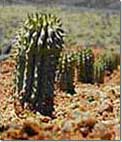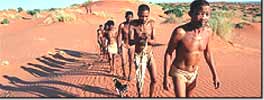| |
Hoodia gordonii, "Whoo De AH", is the botanical name for a leafless, spiky succulent plant that grows throughout the semi-arid areas of Southern Africa primarily the Kalahari desert. The San (local inhabitants) have rationally used Hoodia stems to stave off hunger and thirst when on long journeys, as it acts as an appetite suppressant.
|

A molecule in the cactus
makes you feel full
|

The San bushmen have eaten the plant for years
|
After years of careful research, scientists isolated several compounds in this all-natural food that was responsible for dramatic weight loss, P57, which has been widely reported, is but one of several chemical compounds found in the Hoodia succulent. Not only was it proven completely safe, it contains no stimulates that could contribute to the jittery feeling associated with weight loss products of the last decade.
Hoodia is registered as a protected species to prevent Bio-Piracy but is allowed to be grown on a handful of commercial farms in South Africa owned by private farmers.
In the wild Hoodia takes 5-6 years to mature but is now being cultivated in as little as 2 years commercially in sustainable quantities and has become widely known for its effects as an appetite suppressant.
To be eligible for export to the USA and all other nations, Hoodia farmers must obtain a C.I.T.E.S. certificate which is issued on a per export-shipment basis.
|
| |
| |
| How The New Hoodina™ 100% Pure Hoodia Liquid Extract Works |
|
The chemical constituents in Hoodina™ work within the satiety center by releasing a chemical compound similar to glucose, but is up to 100,000 times more powerful. The hypothalamus receives this signal as an indication that enough food has been consumed and this in turn stunts the appetite. This pure organic Hoodia, contains a miracle molecule that, in effect, fools the brain into believing you are full, and even stops you from thinking about food.
|
 |
| |
| |
| Hoodia Research and Clinical Studies |
|
|
The Science behind Hoodia Gordonii
Is there evidence that Hoodia Gordonii works as an appetite suppressant? Yes! For thousands of years the Bushmen of South Africa having been eating Hoodia Gordonii to fight off hunger during their long hunting trips. The appetite suppressant power of Hoodia Gordonii for the Bushmen is not a question, it is a simple fact of life. So while the Bushmen did not do formal clinical studies, there is thousands of years of real world evidence that eating Hoodia suppresses your appetite.
Phytopharm clinical studies performed with Hoodia P57
Phytopharm completed a double-blind, placebo-controlled clinical study in overweight, but otherwise healthy volunteers using the P57 extract from Hoodia Gordonii. The participants were split into two groups, one received the P57 and the other received a placebo. Each group was told to continue their normal diet and exercise. The results of the study were as follows:
When comparing the P57 group to the Placebo group:
The P57 group had a statistically significant reduction in caloric intake
The P57 group had a statistically significant reduction in body fat
The P57 had no adverse side effects
On average the P57 group ate about 1,000 calories a day less than those in the control group. These are very impressive results when you consider that the average American man consumes about 2,600 calories a day; a woman about 1,900. (References Below)
Brown University Medical School Research on Hoodia effects with Rats
Researchers at Brown University Medical School performed studies in 2004. In these studies "Zucker Rats" were fed Hoodia. Zucker Rats are special rats that are bred to be obese and diabetic. Amazingly Zucker Rats that were fed Hoodia lost weight and even saw some reversal of their diabetes. Anything that can stop a rat from eating is very significant! (References Below)
References
-
Van Heerden FR, Vleggaar R, Horak RM, Learmonth RA, Maharaj V, Whittal RD. Pharmaceutical compositions having appetite suppression activity. United States Patent 6,376,657, issued April 23, 2002.
-
Tulp OL, Harbi NA, Mihalov J, DerMarderosian A. Effect of Hoodia plant on food intake and body weight in lean and obese LA/Ntul//-cp rats. FASEB J 2001 Mar 7;15(4):A404.
-
Tulp OL, Harbi NA, DerMarderosian A. Effect of Hoodia plant on weight loss in congenic obese LA/Ntul//-cp rats. FASEB J 2002 Mar 20;16(4):
-
Habeck M. A succulent cure to end obesity. Drug Discovery Today, March 2002, pp 280-1.
|
| |
|
|